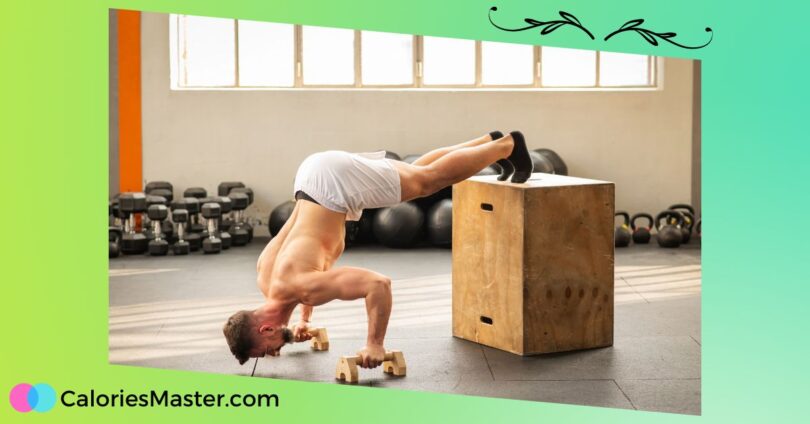If you’re looking for a challenging bodyweight exercise that targets your shoulders, triceps, and chest, then look no further than the pike push-up. This variation of the traditional push-up involves lifting your hips up into an inverted V-shape, which places more emphasis on your shoulders.
Not only is it a great way to build strength and tone your upper body, but it can also improve your core strength, posture, and balance.
The primary muscles worked during a pike push-up are the deltoids, triceps, and chest, but several secondary and stabilizing muscles are also engaged. These include the biceps, forearms, upper back, and abdominals.
By targeting multiple muscle groups, pike push-ups can help you build well-rounded upper body strength and improve your overall fitness level.
Whether you’re a beginner or an experienced fitness enthusiast, there are several variations and modifications of the pike push-up that you can try. From deficit pike push-ups to ring pike push-ups, there are plenty of ways to challenge yourself and make progress towards your fitness goals.
So, if you’re ready to take your upper body workout to the next level, give the pike push-up a try.
Primary Muscles Worked
If you’re looking for an exercise that can help you build strength and size in your upper body, then the pike push-up is a great option to consider. This exercise primarily targets the shoulder muscles, but it also activates other muscles in the upper body.
Shoulder Musculature
The pike push-up is a great exercise for developing the shoulder muscles. Specifically, the deltoid muscles are heavily involved in this exercise.
The deltoids are the muscles responsible for lifting your arms overhead and are made up of three parts: the anterior deltoid, the middle deltoid, and the posterior deltoid.
During the pike push-up, all three parts of the deltoid muscles are activated, making it an effective exercise for building overall shoulder strength and size.
Upper Pectoral Group
The pike push-up also targets the upper pectoral group, which is the muscle group located in the upper chest area. This muscle group is responsible for pulling your arms in towards your chest and is heavily involved in exercises like push-ups and bench presses.
During the pike push-up, the upper pectoral group is activated to help stabilize your body as you push yourself up.
Trapezius and Serratus Anterior
In addition to the deltoids and upper pectoral group, the pike push-up also activates other muscles in the upper body, including the trapezius and serratus anterior muscles.
The trapezius muscle is located in the upper back and neck area and is responsible for moving your shoulder blades. During the pike push-up, the trapezius muscles are activated to help stabilize your shoulder blades.
The serratus anterior muscle is located on the side of the chest and is responsible for pulling your shoulder blades forward.
During the pike push-up, the serratus anterior muscles are activated to help stabilize your shoulder blades and keep them in the correct position.
Overall, the pike push-up is an effective exercise for building strength and size in the upper body. By targeting the shoulder muscles, upper pectoral group, trapezius, and serratus anterior muscles, you can develop a well-rounded upper body that is both strong and aesthetically pleasing.
Secondary Muscles Engaged
In addition to the primary muscles worked during pike push-ups, there are also several secondary muscle groups that are engaged throughout the movement. These secondary muscles play an important role in maintaining proper form and increasing overall strength.
Triceps Brachii
The triceps brachii, located on the back of the upper arm, are heavily engaged during pike push-ups. As you lower your body towards the ground, your triceps contract to help control the movement and support your body weight.
By strengthening the triceps, you can improve your overall pushing strength and reduce your risk of injury.
Core Stability Muscles
Core stability muscles, including the rectus abdominis, transverse abdominis, and obliques, are also engaged during pike push-ups.
These muscles help to maintain proper form throughout the movement and prevent your lower back from sagging or arching. By strengthening your core stability muscles, you can improve your overall posture and reduce your risk of lower back pain.
Overall, pike push-ups are a highly effective exercise for targeting the deltoids, triceps, and chest, as well as several secondary muscle groups.
By incorporating pike push-ups into your workout routine, you can build strength, improve your posture, and reduce your risk of injury.
Pike Push-Up Variations
If you have mastered the basic pike push-up, you can take your workout to the next level by trying some of the more challenging variations. Here are two popular variations to try:
Feet-Elevated Pike Push-Up
This variation adds an extra challenge to your pike push-up by elevating your feet on a bench, box, or step. By elevating your feet, you increase the range of motion and put more emphasis on your shoulders and upper chest muscles.
To perform a feet-elevated pike push-up:
- Begin in a downward dog position with your feet elevated on a bench, box or step.
- Keep your arms straight, and lower your head towards the ground by bending your elbows.
- Push back up to the starting position.
Handstand Pike Push-Up
The handstand pike push-up is a very challenging variation that requires a lot of upper body strength and balance. This variation is performed in a handstand position with your feet resting against a wall.
To perform a handstand pike push-up:
- Begin in a handstand position with your feet resting against a wall.
- Slowly lower your head towards the ground by bending your elbows.
- Push back up to the starting position.
It’s important to note that the handstand pike push-up is an advanced exercise and should only be attempted by experienced athletes. If you’re new to pike push-ups, start with the basic version and work your way up to the more challenging variations.
Benefits of Pike Push-Ups
Pike push-ups offer a variety of benefits to your upper body muscles, making them a great addition to your workout routine. Here are some of the benefits of pike push-ups:
1. Strengthening the Shoulder Muscles
Pike push-ups primarily target your shoulder muscles, including the anterior, medial, and posterior deltoids. The deltoids are responsible for lifting your arms and rotating them, and they also help with pushing movements.
Pike push-ups help to strengthen your shoulder muscles, which can improve your posture and make daily activities easier.
2. Engaging the Triceps
In addition to the shoulder muscles, pike push-ups also engage your triceps, which are located on the back of your upper arm. The triceps are responsible for extending your arms and are often used in pushing movements.
By engaging your triceps during pike push-ups, you can help to tone and strengthen these muscles.
3. Improving Core Stability
Pike push-ups require you to engage your core muscles to maintain proper form throughout the exercise. Your core muscles include your abs, obliques, and lower back muscles, which are responsible for stabilizing your body and helping with movements such as bending and twisting.
By improving your core stability through pike push-ups, you can also improve your overall balance and coordination.
4. Scalability
Pike push-ups are a scalable exercise, meaning that they can be modified to suit your fitness level. For example, you can perform pike push-ups on an elevated surface, such as a bench or step, to make the exercise easier.
Alternatively, you can perform decline pike push-ups or ring pike push-ups to make the exercise more challenging.
Overall, pike push-ups are an effective exercise for strengthening your upper body muscles, improving your core stability, and increasing your overall fitness level.
Incorporating pike push-ups into your workout routine can help you achieve your fitness goals and improve your overall health and well-being.
Common Mistakes and Corrections
When performing pike push-ups, people make some common mistakes. Here are some of the most common mistakes and how to correct them:
1. Improper Form
One of the most common mistakes when performing pike push-ups is improper form. This can lead to injury and prevent you from getting the most out of the exercise.
Make sure that your hands are shoulder-width apart, your feet are hip-width apart, and your body is in a straight line from your head to your heels. Keep your core tight and your glutes engaged throughout the exercise.
2. Arching Your Back
Another common mistake is arching your back. This can put unnecessary strain on your lower back and prevent you from properly engaging your shoulders. To correct this, focus on keeping your body in a straight line and avoid letting your hips sag or your back arch.
3. Rounding Your Shoulders
Rounding your shoulders is another common mistake that can prevent you from properly engaging your shoulder muscles. To correct this, focus on keeping your shoulders down and back throughout the exercise. Imagine that you are trying to squeeze a pencil between your shoulder blades.
4. Improper Breathing
Breathing is an important part of any exercise, and pike push-ups are no exception. Make sure that you are breathing properly throughout the exercise. Inhale as you lower your body towards the ground, and exhale as you push yourself back up.
5. Overtraining
Finally, overtraining is another common mistake that people make when performing pike push-ups. Make sure that you are allowing your muscles to rest and recover between workouts.
Aim to perform no more than three sets of pike push-ups per workout, and take at least one day off between workouts to allow your muscles to recover.
By avoiding these common mistakes and focusing on proper form and technique, you can get the most out of your pike push-up workouts and avoid injury.









